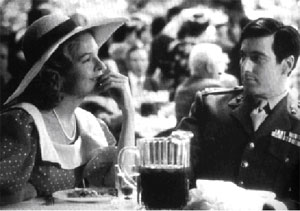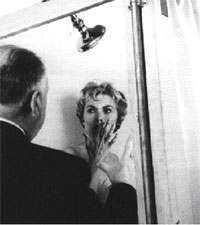When I picked up this marvelously rich book, I tried to recall what I knew about film editing, and came up with obvious examples of the craft: the way Orson Welles indicated the transition of time at the breakfast table in Citizen Kane by the graying hair and faces of Kane and his wife; the synchronization of William Walsh's soundtrack and the flight of arrows at the Battle of Agincourt in Olivier's Henry V; the swift cut from the flare of a match to the vast, mysterious desert in David Lean's Lawrence of Arabia; the shower-scene in Hitchcock's Psycho, with its staccato rhythm and shrieking soundtrack, where we "see" the killer brutally stabbing Janet Leigh though there is never any direct contact between the knife and her flesh; or the signature tempo, sound, and rhythm to indicate the next shark attack in progress in Jaws. There were many other highlights that I could cite¨from Eisenstein, Bergman, Godard, Truffaut, Coppola, Fosse, Ford, et cetera¨but I didn't yet know about subliminal influences, precipitant and metaphorical sound, how the location and positioning of a microphone can create an intricate narrative tone, how music allows you to dissolve a certain emotion on film and carry it in a certain direction, the "spaghetti-sauce" and Procrustean methods of reducing a film's length, divergent and convergent points of view and the influence they have on a film's length and scope, and, most of all, the real power of film editing.

It was Orson Welles who maintained that editing was more important than directing, for "the only time one is able to exercise control over the film is in the editing." Welles knew all too well that the external and internal organization of a film, the orchestration of all its disparate elements, are properly within the power of the one who cuts and rearranges the raw footage in the editing room where "the full eloquence of cinema" is achieved. But this eloquence has not been properly experienced to an appreciable degree in a book. Ondaatje is the first to demystify an art that he says is "mostly unimagined and certainly overlooked." He gives us a book that is investigative, meditative, and creatively organized like a montage of ideas, digressions, and patterns. Or to put it another way, Ondaatje succeeds in turning a book (and the reading experience which is not finite) into an artefact or extension of film (which is usually consumed at "one go" and at its own completed narrative speed). A master of virtually every genre he has attempted¨poetry, the novel, memoir, literary criticism, experimental documentary film¨Ondaatje seems to have created a new genre: the book as metaphor for documentary film. The Conversations (the title is an homage to Francis Ford Coppola's The Conversation, on which Walter Murch was responsible for film editing, sound montage, and re-recording mix) is discursively unhurried, filled with testimonials from film eminences (George Lucas, Francis Ford Coppola, Anthony Minghella, et cetera), and generously illustrated (sometimes in full colour) with stills and documentary material from editing notes, screenplays, line drawings, film frames, photo boards, memos, manuscript pages, pre-production, post-production, and "shooting" candids. The book has a substantial expertise that demystifies the subject without necessarily plucking out the heart of its mystery. It would not be what it is without either Michael Ondaatje or Walter Murch.
Ondaatje is evidently a sophisticated film fan, and in Oscar-winning editor Walter Murch, he has the perfect person for an interrogation, for Murch is that rarity in Hollywood¨a Renaissance man with a far-ranging mind that goes far beyond the sheer subject of film and filmmaking. Murch speaks interestingly on Beethoven, Edison, Flaubert, Curzio Malaparte (whose prose he is translating into poetry!), Frank L. Baum (Murch directed Return to Oz), the I Ching, painting, medieval architecture, et cetera. He has, as Ondaatje says, worked on projects "that have become central to the culture of our times," for he has done sound and/or picture editing for American Graffiti, The Conversation, The Godfather trilogy, Julia, Apocalypse Now, The Unbearable Lightness of Being, Ghost, and The English Patient. He is the one who re-cut Touch of Evil (acting closely on Welles' 58-page memo, a sample of which appears in the text) and who wrote In The Blink of an Eye (which Ondaatje calls "a sort of 'Zen and the Art of Editing'").

The son of Canadians (his mother was born to missionary doctors in Ceylon; his painter-father to a musical family in Toronto), Murch developed an obsession with sound in his boyhood. He would produce sounds when he couldn't think of a word, so he was nicknamed Walter McBoing-Boing after the cartoon character Gerald McBoing-Boing who spoke only in sound effects. When he was old enough to work a tape-recorder, Murch recorded sounds of New York City (his birthplace) and discovered how to physically edit tape. At ten, he was inspired by European musique concrete of the 50s¨the name for ordinary sounds rhythmically arranged. It was only when he made silent films at Johns Hopkins University that he felt the emotional impact of editing images. Then as a graduate-student at University of Southern California, sound and picture came together for him. It was a time when the French New Wave was at its height, and his most significant role models were the Europeans and Japanese (Godard, Truffaut, Fellini, Bergman, Kurosawa). As he tells Ondaatje, he was deeply affected by the freeze-frame at the end of The 400 Blows and the use of slow motion in The Seven Samurai.
Murch bonded with George Lucas (his peer at USC) and Francis Ford Coppola (who was at UCLA), and was sought out by the two to do final sound editing on The Rain People, a film that was shot on the road with a crew of only fourteen. It was onward, upward, higher, and deeper after that, with Murch quickly learning how far editing had moved from the days where leading (and the best) studio editors were women who treated the craft as if it were a form of "knitting." As he showed Ondaatje on the re-edited Apocalypse Now, Murch can pick up a hint of a hum on a soundtrack, "hiding within a twenty-track scene made up of gunfire, burning napalm, shouted orders, and helicopters." Like a writer, he moves pictures and sounds around till they become sharp and clear, citing Robert Bresson's claim that a film is born three times¨in the script, the shooting, and the editing. Ondaatje wryly points out that in the case of an adaptation, such as of The English Patient, there is a fourth birth because the source is a novel. Their five conversations (spread over slightly more than a year in San Francisco, Los Angeles, New York, and Toronto) make for a fruitful symbiotic relationship, with both men revealing how they are continually being fed and diverted by what Ondaatje calls "the possibilities from the world around one¨chance anecdotes overheard, the texture within a rumour"¨as much as by what research or technique reveals.
The Conversations is a great book. Because Ondaatje and Murch have similar attitudes to creativity¨neither has "a strict controlling governor" present in the early stages of writing or editing¨their conversations move as deeply into process as into product. Murch offers the sort of sharp, precise details that are missed even by astute film critics¨such as the significance of Harry Caul's name and costuming in Coppola's The Conversation or the subliminal implications of the sound of a distant bell at the moment when the Patient eats a plum in Minghella's The English Patient (a point that is really introduced into discussion by Ondaatje) or the dramatic tension and power in The Godfather trilogy when music is brought in only after big scenes are played in silence. Ondaatje and Murch complement each other perfectly, probably because both have open, flexible minds with shared curiosities, acutely sensitive sensory antennae, similar approaches to their different crafts, and degrees of articulateness that are enormously rewarding to readers. ˛
Keith Garebian's new book is The Making of 'Guys and Dolls' (Mosaic Press) .